Hand and Wrist Intrinsic Muscles
Intrinsic Muscles: Precision and Fine Control
The intrinsic muscles of the hand are located within the hand itself and are specialized for delicate movements and fine motor skills. Here’s a more detailed exploration of their functions:
Thenar and Hypothenar Muscles: Masters of Pinching and Grasping
The thenar and hypothenar muscles are specialized muscle groups in the hand that control the thumb and little finger. Their unique functions enable a wide array of movements and tasks:
- Opposition: The ability to touch the thumb to other fingers, known as opposition, is a defining human trait. It enables us to hold objects securely and perform intricate tasks.
- Pinching and Grasping: From holding a pencil to pinching a needle, the thenar muscles provide the control needed for precise manipulation.
- Daily Activities: These muscles are essential for everyday tasks like opening jars, turning keys, or using touchscreens.
- Occupational Relevance: Professionals like surgeons, mechanics, or artists rely on the thenar muscles for precision and control in their work.
Thenar Muscles: The Thumb’s Powerhouse
The thenar muscles are located at the base of the thumb and are responsible for its unique movements:
Thenar Muscle Anatomy and Function:
The thenar muscles are a group of muscles located in the thenar eminence, the fleshy mound at the base of the thumb. These muscles are responsible for the thumb’s unique and highly specialized movements, allowing for a wide array of functions. Let’s explore these muscles and their specific roles:
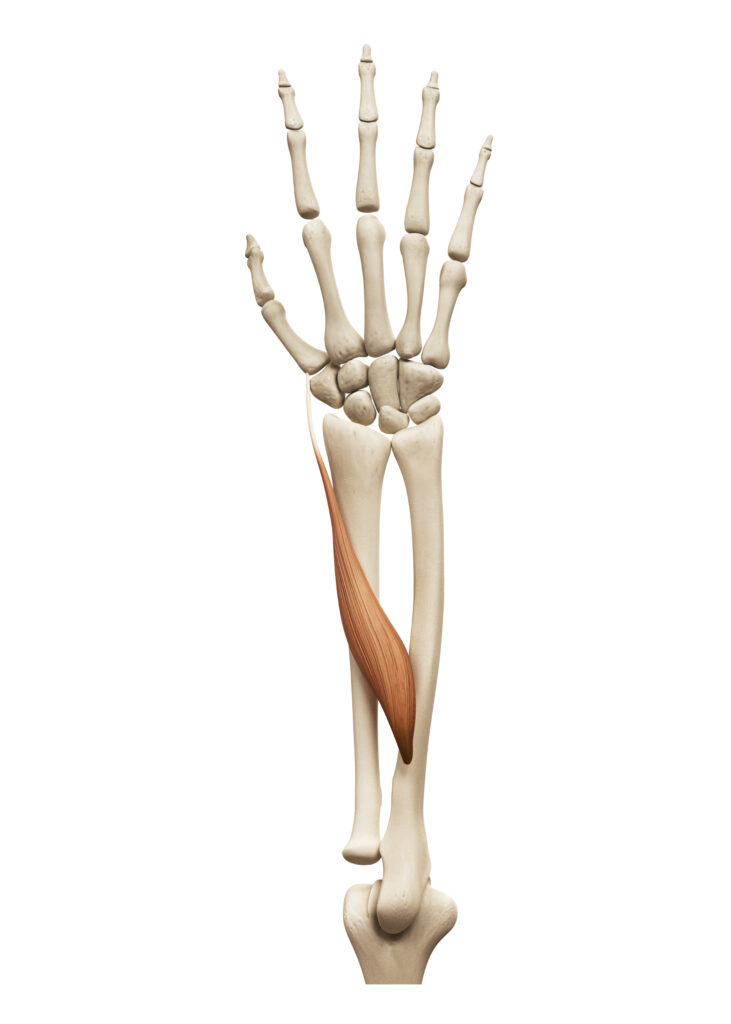
1. Abductor Pollicis Brevis (APB)
- Function: Abducts the thumb, moving it away from the palm. This movement is vital for grasping large objects and opposing the thumb to the other fingers.
- Innervation: Median nerve (recurrent branch).
2. Flexor Pollicis Brevis (FPB)
- Function: Flexes the thumb at the metacarpophalangeal joint, allowing actions like pinching or making a fist.
- Innervation: Median nerve (recurrent branch) and ulnar nerve (deep branch) for the deep head.
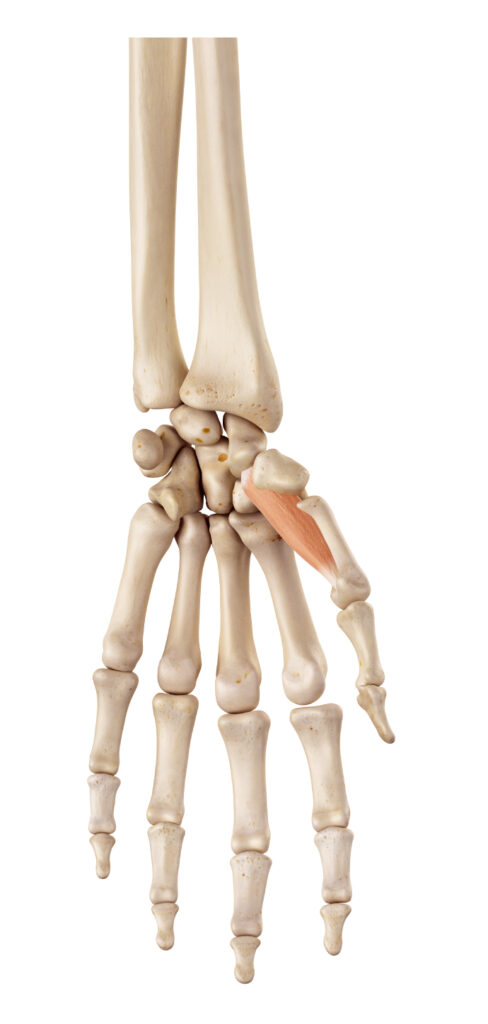
3. Opponens Pollicis (OP)
- Function: Opposes the thumb, rotating it towards the little finger. This movement enables a wide range of grasping and manipulating actions.
- Innervation: Median nerve (recurrent branch).
4. Adductor Pollicis (Not Part of Thenar Eminence but Related)
- Function: Adducts the thumb, moving it towards the palm. It assists in gripping and pinching.
- Innervation: Ulnar nerve.
Combined Functions and Movements
- Gripping and Pinching: The thenar muscles allow for precise pinching and gripping by controlling thumb flexion, abduction, and opposition.
- Manipulating Objects: The ability to oppose the thumb to the fingers enables intricate manipulation of objects, such as holding a pen or using tools.
- Texting or Typing: These muscles are heavily involved in modern activities like texting on a smartphone or using a computer keyboard.
Clinical Relevance
- Carpal Tunnel Syndrome: Compression of the median nerve can affect the thenar muscles, leading to weakness or atrophy.
- De Quervain’s Tenosynovitis: Inflammation affecting the tendons of the APB and other thumb muscles may cause pain and dysfunction.
- Therapeutic Interventions: Techniques like tuning fork therapy may be applied to the thenar muscles to alleviate discomfort, improve fluid movement, and enhance thumb function.
The thenar muscles are central to the thumb’s unique movements, providing the dexterity and strength that set human hands apart. Whether in daily tasks, specialized skills, or therapeutic contexts, understanding these muscles offers insights into the biomechanics of the hand and the pathways to healing and enhancement. The thenar muscles’ ability to abduct, flex, oppose, and (with the related adductor) adduct the thumb underlies much of what makes our hands so versatile and expressive.
Hypothenar Muscles: The Little Finger’s Delicate Control
The hypothenar muscles control the little finger and contribute to hand dexterity:
- Specialized Grips: These muscles enable specialized grips, such as holding a teacup with elegance or playing specific chords on a guitar.
- Fine Motor Skills: The hypothenar muscles contribute to delicate tasks like tying a ribbon or creating intricate artwork.
- Emotive Gestures: The little finger’s movements, controlled by the hypothenar muscles, can also be used in expressive gestures, such as making a “pinky promise.”
- Cultural Significance: In some cultures, the way the little finger is used, such as in traditional tea ceremonies, has symbolic or ritualistic importance.
Hypothenar Muscles Anatomy and Function:
The hypothenar muscles are a group of muscles located in the hypothenar eminence, the fleshy mound at the base of the little finger. These muscles are responsible for controlling the movements of the little finger, contributing to the overall dexterity and function of the hand. Let’s explore these muscles and their specific roles:
1. Abductor Digiti Minimi (ADM)
- Function: Abducts the little finger, moving it away from the hand. This movement assists in spreading the fingers.
- Innervation: Ulnar nerve.
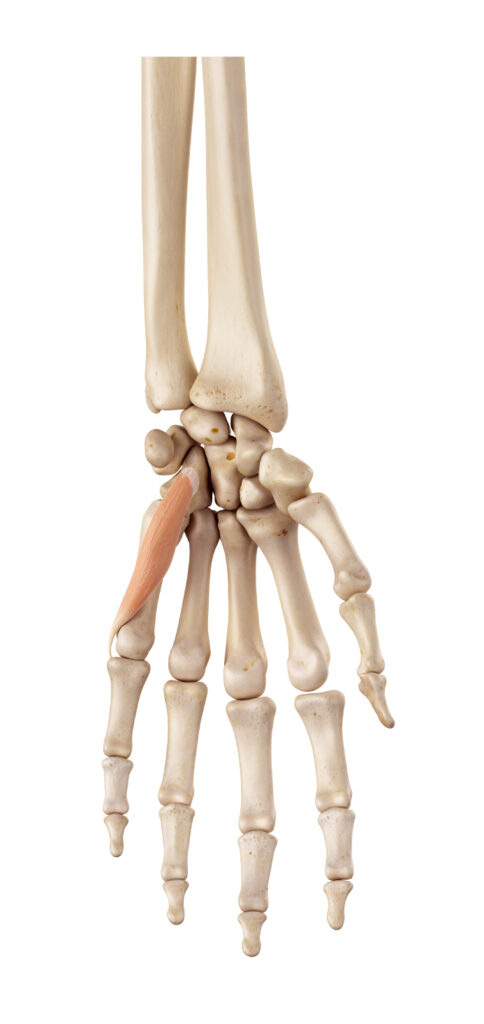
2. Flexor Digiti Minimi Brevis (FDMB)
- Function: Flexes the little finger at the metacarpophalangeal joint, enabling actions like gripping or making a fist.
- Innervation: Ulnar nerve.
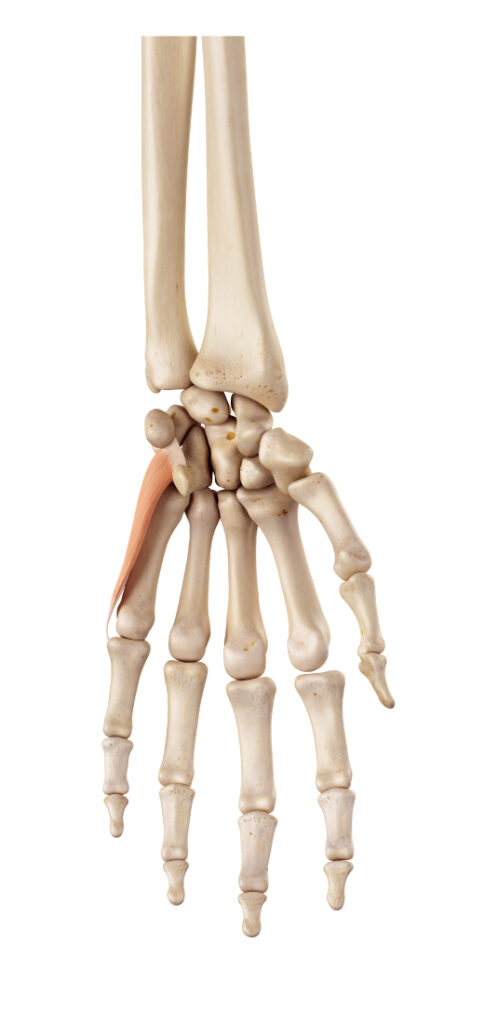
3. Opponens Digiti Minimi (ODM)
- Function: Opposes the little finger, rotating it towards the thumb. This movement enhances the hand’s ability to grasp and hold objects.
- Innervation: Ulnar nerve.
Combined Functions and Movements
- Grasping and Holding: The hypothenar muscles allow for a secure grasp and holding of objects by controlling little finger flexion, abduction, and opposition.
- Manipulating Objects: These muscles enhance the hand’s ability to manipulate objects with finesse and control, contributing to actions like writing, painting, or playing musical instruments.
- Enhancing Grip: The hypothenar muscles add stability to the grip, particularly when holding larger objects or exerting force with the hand.
Clinical Relevance
- Ulnar Nerve Entrapment: Compression or damage to the ulnar nerve can affect the hypothenar muscles, leading to weakness, atrophy, or loss of function.
- Hypothenar Hammer Syndrome: Repeated trauma to the hypothenar eminence can cause vascular injury, leading to symptoms in the little finger.
- Therapeutic Interventions: Techniques like tuning fork therapy may be applied to the hypothenar muscles to alleviate discomfort, improve mobility, and restore function.
The hypothenar muscles are vital to the control and dexterity of the little finger, adding depth and versatility to the overall function of the hand. Their ability to abduct, flex, and oppose the little finger enables a wide array of tasks and specialized skills. Whether in daily life, artistic pursuits, or therapeutic contexts, understanding these muscles offers insights into the biomechanics of the hand and the pathways to healing and enhancement. The hypothenar muscles may be less prominent than their thenar counterparts, but they play a vital role in the hand’s intricate dance of movement and expression.
The thenar and hypothenar muscles are specialized groups within the hand that control the thumb and little finger, respectively. Their unique functions enable a wide array of movements, from the power and precision of the thumb to the delicate control of the little finger. Understanding these muscles can provide valuable insights into human dexterity, cultural practices, occupational demands, and therapeutic interventions. In the context of Astrion Academy’s innovative approach to learning, exploring the thenar and hypothenar muscles can inspire students to appreciate the complexity and versatility of the human hand. Whether in daily tasks, creative expressions, professional endeavors, or human connections, these muscles play a vital role in shaping our interaction with the world around us.
Interossei and Lumbricals: Masters of Intricate Movements
The interossei and lumbricals are specialized muscles within the hand that control complex finger movements. Their unique functions enable a wide array of delicate and precise tasks:
Interossei Muscles: Adduction and Abduction
The interossei muscles are located between the metacarpal bones in the hand and are responsible for finger adduction and abduction:
- Adduction: This movement brings the fingers together, essential for gripping objects or making specific hand gestures.
- Abduction: This movement spreads the fingers apart, necessary for tasks like typing, playing certain musical instruments, or creating shadow puppets.
- Fine Motor Control: The interossei muscles contribute to the hand’s overall dexterity, allowing for intricate tasks like painting or sculpting.
- Therapeutic Importance: Understanding the interossei muscles is vital for rehabilitation professionals working with patients to regain fine motor control after injuries or neurological conditions.
Interossei Muscles Anatomy and Function:
The interossei muscles in the hand are vital for the precise control of finger movement, specifically in adduction and abduction. These muscles are located between the metacarpal bones and are categorized into two groups: dorsal interossei (DI) and palmar interossei (PI). Here’s a closer look at these muscles:
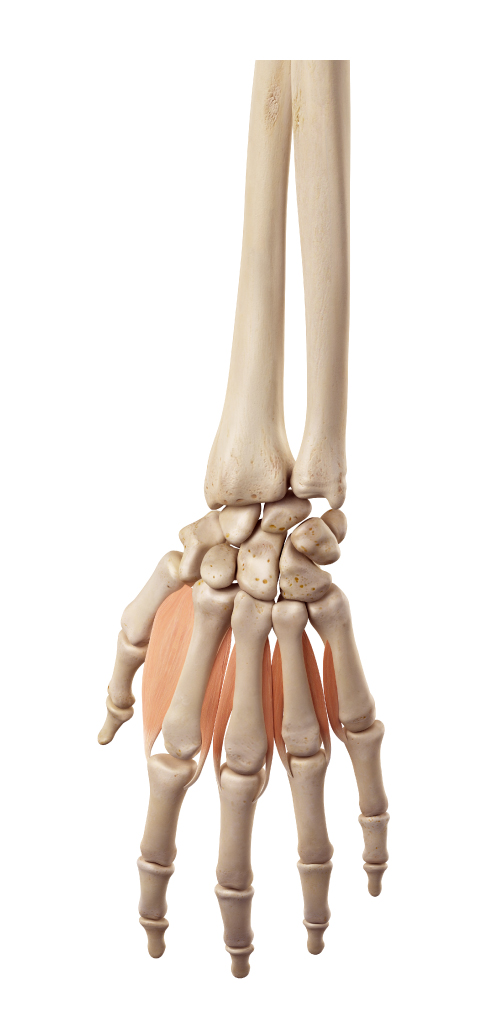
Dorsal Interossei (DI)
- Number: There are four dorsal interossei muscles.
- Location: Located between the metacarpal bones on the dorsal (back) side of the hand.
- Function: Abducts the fingers, moving them away from the midline (third finger). This action helps spread the fingers apart.
- Innervation: Ulnar nerve.
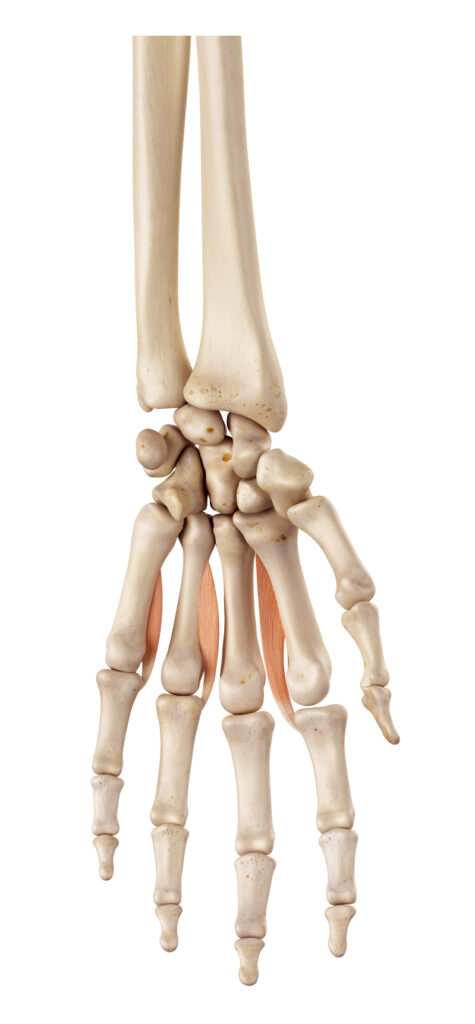
Palmar Interossei (PI)
- Number: There are three palmar interossei muscles.
- Location: Located between the metacarpal bones on the palmar (front) side of the hand.
- Function: Adducts the fingers, moving them towards the midline (third finger). This action helps bring the fingers together.
- Innervation: Ulnar nerve.
Combined Functions and Movements
- Finger Abduction and Adduction: The interossei muscles enable precise control over finger spreading (abduction) and closing (adduction), essential for tasks like typing, playing musical instruments, or grasping different-sized objects.
- Assisting in Flexion and Extension: While not their primary function, interossei muscles also assist in finger flexion at the metacarpophalangeal joints and extension at the interphalangeal joints, contributing to the hand’s dexterity.
Clinical Relevance
- Ulnar Nerve Injury: Since both the DI and PI are innervated by the ulnar nerve, injury to this nerve can lead to weakness or loss of finger adduction and abduction.
- Hand Rehabilitation: Understanding the function of the interossei muscles is crucial for therapists working on hand rehabilitation, especially in cases requiring the restoration of fine motor skills.
- Therapeutic Interventions: Techniques like tuning fork therapy may target the interossei muscles to improve mobility, strength, and coordination.
The interossei muscles are intricate and vital components of hand function, allowing for the nuanced control of finger movement. Their ability to adduct and abduct the fingers enables a wide range of tasks and specialized skills, from simple gestures to complex craftsmanship. Understanding the interossei muscles’ anatomy, function, and clinical relevance offers insights for healthcare professionals and anyone interested in the marvel of hand biomechanics. Whether contributing to the art of expression or the restoration of function, the interossei muscles underscore the complexity and adaptability of the human hand.
Lumbricals: Complex Finger Movements
The lumbricals are small muscles that originate from the tendons of the flexor digitorum profundus and assist in complex finger movements:
- Flexing and Extending: The lumbricals assist in flexing the metacarpophalangeal joints and extending the interphalangeal joints, enabling movements like tying a knot, threading a needle, or performing delicate surgical procedures.
- Adaptive Functionality: These muscles allow the fingers to adapt to various shapes and textures, whether holding a soft sponge or manipulating a hard tool.
- Artistic Expression: Artists, musicians, and craftsmen rely on the lumbricals for the fine control needed in their creative work.
- Sensory Integration: The lumbricals work closely with sensory receptors in the hand, allowing us to feel and manipulate objects with precision and sensitivity.
Lumbricals Anatomy and Function:
The lumbricals are small, unique muscles in the hand that play a specific role in complex finger movements. Originating from the tendons of the flexor digitorum profundus, they have a distinctive structure and function. Here’s a detailed look at the lumbricals:

Anatomy
- Number: There are four lumbrical muscles in the hand, one for each finger (excluding the thumb).
- Origin: The lumbricals originate from the tendons of the flexor digitorum profundus.
- Insertion: They insert into the extensor expansions on the dorsal aspect of the proximal phalanges of the fingers.
- Innervation: The first and second lumbricals are innervated by the median nerve, while the third and fourth are innervated by the ulnar nerve.
Function
- Flexion at the Metacarpophalangeal Joints: The lumbricals assist in flexing the fingers at the metacarpophalangeal (MCP) joints. This helps in forming a grip or holding objects.
- Extension at the Interphalangeal Joints: Simultaneously, they extend the fingers at the interphalangeal (IP) joints, contributing to the fine control of finger position.
- Coordinated Action: Working in conjunction with other hand muscles, the lumbricals enable complex and precise finger movements, vital for activities like writing, playing musical instruments, or manipulating small objects.
Clinical Relevance
- Carpal Tunnel Syndrome: Since the first two lumbricals are innervated by the median nerve, compression of this nerve in the carpal tunnel can affect their function.
- Claw Hand Deformity: Dysfunction of the lumbricals, especially those innervated by the ulnar nerve, can contribute to a claw hand deformity, affecting hand appearance and function.
- Therapeutic Interventions: Techniques like tuning fork therapy may be applied to the lumbricals to improve mobility, alleviate discomfort, and enhance finger coordination.
The lumbricals are small yet essential muscles in the hand, contributing to the intricate dance of finger movement. Their dual action of flexing at the MCP joints and extending at the IP joints enables a wide array of tasks and specialized skills. Whether in artistic expression, daily chores, or therapeutic contexts, understanding the lumbricals offers insights into the biomechanics of the hand and the pathways to healing and enhancement. The lumbricals remind us of the complexity and adaptability of the human body, even in its smallest and most delicate structures.
The interossei and lumbricals are specialized muscles within the hand that enable intricate and complex finger movements. From the adduction and abduction controlled by the interossei to the flexing and extending enabled by the lumbricals, these muscles allow us to perform a wide array of delicate and precise tasks. Understanding these muscles can provide valuable insights into human dexterity, artistic expression, occupational demands, and therapeutic interventions.
Artistic Expression: The Creative Touch
The intrinsic muscles of the hand are essential contributors to the world of artistic expression. They enable the fine motor control, dexterity, and tactile sensitivity that artists, musicians, and writers rely on to create and perform. Here’s an elaboration on how these muscles facilitate creative touch:
Musicians
- Pianists: The intrinsic muscles allow pianists to control finger movements, enabling the execution of intricate melodies, chords, and dynamics. From gentle legatos to powerful fortissimos, these muscles translate emotion into sound.
- Guitarists: Whether fingerpicking or strumming, guitarists rely on the intrinsic muscles for precision, strength, and coordination, creating rich harmonies and rhythms.
- Wind and String Players: Musicians playing instruments like the violin, flute, or cello depend on the fine control of the intrinsic muscles for bowing, fingering, and embouchure, shaping the tone and expressiveness of their music.
Artists
- Painters: The intrinsic muscles enable delicate brush strokes, blending, and detailing, allowing painters to create textures, layers, and depth in their artwork.
- Sculptors: Carving, shaping, and molding materials require the strength and finesse of the intrinsic muscles, translating vision into tangible form.
- Illustrators and Graphic Artists: From traditional sketching to digital design, these muscles facilitate the control and creativity needed to bring ideas and stories to life.
Writers
- Handwriting and Calligraphy: The intrinsic muscles allow the precise movements required for elegant handwriting, calligraphy, or drawing, turning letters and words into visual art.
- Creative Writing: Beyond the physical act of writing, these muscles support the process of creating, whether drafting on paper or typing on a keyboard, turning thoughts into narratives, poetry, or scripts.
Dancers and Performers
- Expressive Gestures: Even in dance and physical performance, the intrinsic muscles contribute to expressive hand gestures and poses, adding nuance and emotion to the performance.
Therapeutic Considerations
- Artistic Rehabilitation: Occupational and physical therapists may work with artists and musicians to rehabilitate or enhance the intrinsic muscles’ function following injuries or strain.
- Tuning Fork Therapy: Specific therapeutic modalities like tuning fork therapy can be tailored to artistic needs, improving fluidity, relieving tension, and enhancing sensory perception.
Sensory Integration: The Sense of Touch
The intrinsic muscles of the hand are unsung heroes of artistic expression, enabling the creative touch that turns imagination into reality. Whether in music, visual arts, writing, or performance, these muscles are at the heart of human creativity, translating emotion, thought, and vision into tangible forms of beauty and meaning. Understanding and nurturing these muscles not only supports artistic pursuits but also celebrates the extraordinary capabilities of the human body and the universal language of art. Their role in creativity reminds us that the hand is not just a tool but a bridge between the inner world and the shared experience of culture, connection, and expression.
Sensory integration in the hand is a complex interplay between the intrinsic muscles (including lumbricals, interossei, thenar, and hypothenar muscles) and the sensory receptors that populate the skin and deeper tissues. This integration allows for an incredible degree of tactile sensitivity and motor control. Let’s explore these aspects in more detail:
Tactile Sensitivity
- Sensory Receptors: The hand is rich in sensory receptors like Meissner’s corpuscles, Merkel cells, and Pacinian corpuscles, which detect touch, pressure, vibration, and texture.
- Intrinsic Muscle Coordination: The intrinsic muscles provide fine motor control, allowing precise manipulation of objects. This enables us to distinguish textures, shapes, and temperatures, or handle delicate items like glassware or a baby’s hand.
- Functional Implications: This tactile sensitivity is crucial for tasks requiring finesse, such as sewing, painting, playing musical instruments, or even using touch-screen devices.
Therapeutic Applications
- Occupational Therapy: Therapists work with individuals to improve intrinsic muscle strength, coordination, and sensory integration, especially after injuries or neurological conditions. This rehabilitation enhances daily living skills like cooking, dressing, writing, or personal grooming.
- Sensory Training: Sensory re-education and training may be employed to restore or enhance the sense of touch, particularly following nerve injuries or surgeries.
- Tuning Fork Therapy: Techniques like tuning fork vibration therapy may target specific muscles or areas to improve fluid movement, relieve pain, and enhance sensory perception.
Human Connection and Emotional Aspects
- Expressive Touch: The intrinsic muscles enable gentle and expressive touches, allowing for human connections like comforting a loved one, shaking hands, or hugging. These touches convey emotions and build relationships.
- Animal Interaction: Sensory integration in the hand allows for interactions with animals, such as petting or grooming, fostering bonds and providing therapeutic benefits.
Technological and Prosthetic Considerations
- Haptic Technology: Sensory integration in the hand inspires the development of haptic technology, providing tactile feedback in virtual environments or remote-controlled systems.
- Prosthetic Design: Understanding the hand’s sensory-motor integration informs the design of advanced prosthetics, aiming to replicate the natural sense of touch and movement.
The sensory integration in the hand, facilitated by the intrinsic muscles and sensory receptors, is a marvel of human physiology. It not only allows us to explore and interact with the world around us but also connects us emotionally to others. Whether in daily tasks, artistic pursuits, therapeutic interventions, or technological innovations, the sense of touch underscores our human experience. Understanding and nurturing this integration offers paths to healing, enhancement, innovation, and deeper human connection. The hand’s tactile sensitivity is a gateway to the world and a reflection of our humanity.
